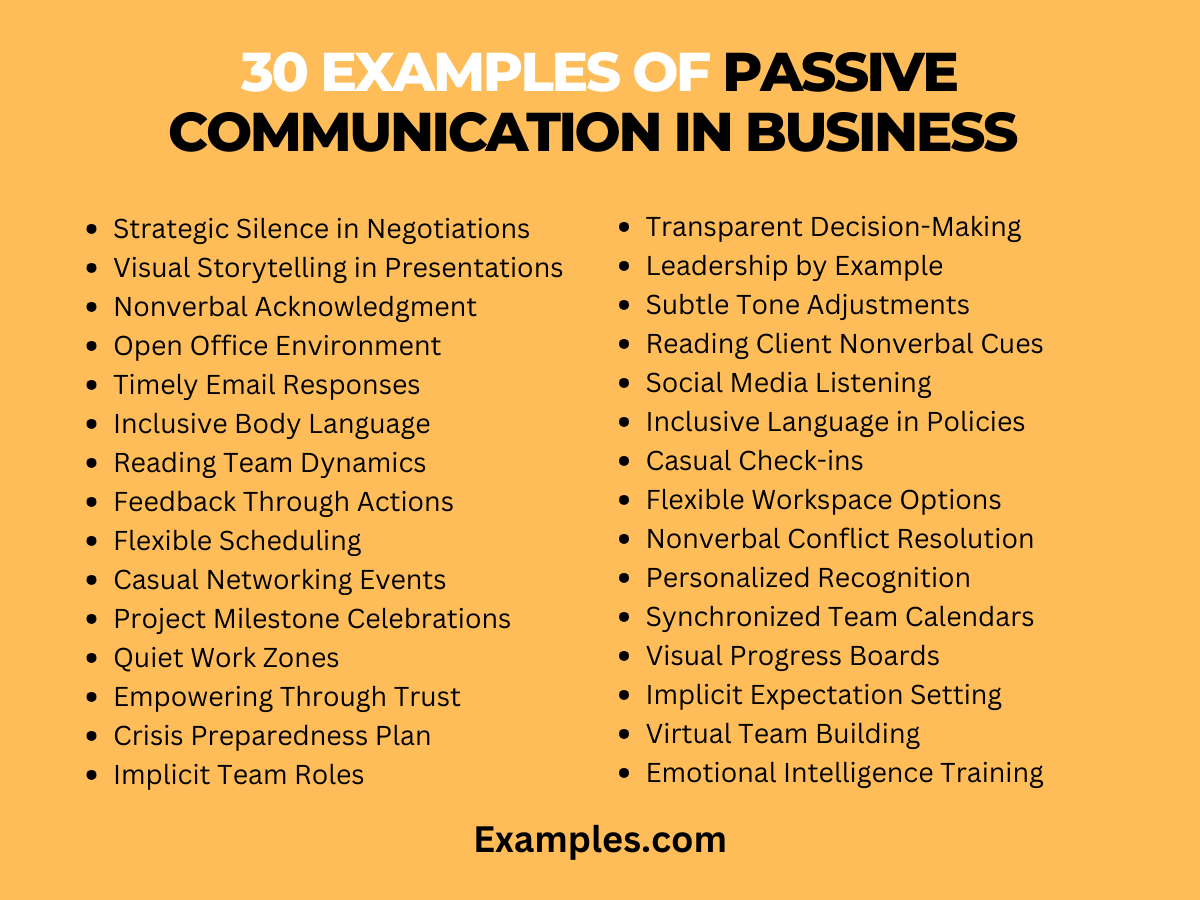29+ Passive Communication in Business Examples
Embark on a comprehensive exploration of passive communication’s pivotal role in the corporate realm. This complete guide delves into the intricacies of nonverbal cues, strategic silences, and the art of reading between the lines in business interactions. Uncover the significance of passive communication, backed by real-world Communication Examples, and elevate your professional prowess by understanding the nuances of this subtle yet impactful approach to business communication.
30 Examples of Passive Communication In Business
Explore the advantages of Passive Communication in Business, where subtlety speaks volumes. Uncover the benefits of fostering a collaborative work environment, enhancing professional relationships, and achieving effective communication strategies that resonate in the corporate world.

- Strategic Silence in Negotiations: Silence during negotiations allows for contemplation, encouraging thoughtful responses and fostering win-win outcomes.
- Visual Storytelling in Presentations: Utilizing visuals conveys complex ideas, making presentations more engaging and accessible to diverse audiences.
- Nonverbal Acknowledgment: A nod or smile in meetings acknowledges colleagues, creating a positive atmosphere and reinforcing team unity.
- Open Office Environment: Office layout and design promote informal interactions, fostering camaraderie and spontaneous collaboration among team members.
- Timely Email Responses: Responding promptly to emails exhibits professionalism and demonstrates a commitment to efficient communication within the organization.
- Inclusive Body Language: Maintaining open and inclusive body language during discussions encourages participation and ensures all voices are heard.
- Reading Team Dynamics: Observing team dynamics helps leaders understand interpersonal relationships, allowing for targeted interventions when necessary.
- Feedback Through Actions: Providing constructive feedback through actions demonstrates commitment to improvement without direct confrontation.
- Flexible Scheduling: Accommodating flexible work hours recognizes employees’ individual needs, promoting a healthy work-life balance.
- Casual Networking Events: Informal gatherings outside the office environment create opportunities for genuine connections and relationship-building.
- Project Milestone Celebrations: Celebrating achievements reinforces a positive work culture and boosts team morale.
- Quiet Work Zones: Designating quiet zones accommodates different work styles, fostering concentration and minimizing distractions.
- Empowering Through Trust: Delegating responsibilities without micromanaging empowers team members and builds trust within the organization.
- Crisis Preparedness Plan: Establishing communication protocols in advance ensures a swift and coordinated response in times of crisis.
- Implicit Team Roles: Recognizing and appreciating team members’ strengths naturally allocates roles, optimizing productivity without formal assignment.
- Transparent Decision-Making: Providing insight into decision-making processes fosters transparency, building trust among team members.
- Leadership by Example: Leaders who embody the values they promote inspire their teams, creating a culture of integrity and accountability.
- Subtle Tone Adjustments: Adjusting communication tone based on situational cues ensures messages are received positively and understood as intended.
- Reading Client Nonverbal Cues: Understanding clients’ nonverbal cues allows for tailored communication, addressing concerns and building rapport.
- Social Media Listening: Monitoring social media channels helps businesses understand customer sentiment, guiding responsive communication strategies.
- Inclusive Language in Policies: Using inclusive language in company policies fosters a sense of belonging and communicates a commitment to diversity.
- Casual Check-ins: Regular, casual check-ins with team members create opportunities for open communication and support, strengthening professional relationships.
- Flexible Workspace Options: Offering flexible workspace options recognizes diverse working preferences, contributing to overall job satisfaction.
- Nonverbal Conflict Resolution: Addressing conflicts through nonverbal cues promotes a calm and respectful approach to resolution.
- Personalized Recognition: Tailoring recognition efforts to individuals’ preferences ensures gestures are meaningful and well-received.
- Synchronized Team Calendars: Shared calendars facilitate coordination, ensuring everyone is informed and aligned on project timelines.
- Visual Progress Boards: Visual representations of project progress enhance communication, providing a quick overview of achievements and pending tasks.
- Implicit Expectation Setting: Setting clear expectations through consistent actions reduces ambiguity and promotes a shared understanding among team members.
- Virtual Team Building: Engaging in virtual team-building activities fosters camaraderie, even in remote work settings, promoting a positive team culture.
- Emotional Intelligence Training: Investing in training to enhance emotional intelligence equips employees with essential skills for perceptive and empathetic communication.
Importance of Passive Communication in Business
Unlock the significance of passive communication in the corporate landscape. Beyond words, passive communication influences workplace harmony, nurtures professional relationships, and shapes organizational culture. Discover how embracing subtleties in communication contributes to a positive work environment, effective teamwork, and heightened business success.
- Silent Recognition in Meetings: Acknowledge contributions with a nod, fostering a positive atmosphere without interrupting discussions.
- Subtle Office Décor: A well-designed office space communicates company values and influences employee morale without explicit statements.
- Email Etiquette: Polite and concise email communication maintains professionalism, showcasing the importance of nonverbal cues in written interactions.
- Unspoken Hierarchies: Office layouts reflecting hierarchy through seating arrangements subtly communicate organizational structure.
- Casual Dress Code: A relaxed dress code fosters a comfortable environment, signalling trust in employees’ judgment and professionalism.
- Consistent Branding: Uniform branding across materials reinforces company identity and values, contributing to a cohesive external image.
- Invisible Diversity Initiatives: Implicitly promoting diversity through inclusive practices ensures equal opportunities without singling out individuals.
- Personalized Workspaces: Allowing employees to personalize their workspaces creates a sense of ownership and contributes to a positive work environment.
- Informal Social Events: Organizing casual gatherings promotes team bonding, reinforcing the importance of non-work-related interactions.
- Mindful Silence in Negotiations: Silence during negotiations allows for thoughtful consideration, emphasizing strategic contemplation over immediate responses.
what are the Roles of Passive Communication in Business
Explore the multifaceted roles of passive communication in the business landscape. From promoting effective leadership to shaping brand identity, passive communication plays a crucial part in nurturing a thriving business environment. Delve into the nuanced responsibilities this subtle communication style undertakes in various facets of corporate interactions.
- Leadership Presence: Leaders exuding calm confidence without dominating conversations foster a positive and authoritative leadership style.
- Brand Persona: Visual elements, colour schemes, and design choices contribute to conveying brand personality, creating a lasting impression.
- Corporate Values Display: Subtle cues in office décor, mission statements, and employee interactions reflect and reinforce company values.
- Team Unity: Shared spaces and collaborative tools foster teamwork without necessitating explicit communication of expectations.
- Client Relationships: Attentive listening and understanding nonverbal cues during client meetings build trust and strengthen business partnerships.
- Crisis Management: Calm demeanour and clear communication during crises help instil confidence in employees and clients alike.
- Professionalism in Networking: Nonverbal cues, such as a firm handshake, convey professionalism and leave a lasting impression during networking events.
- Employee Morale: Passive communication contributes to a positive work environment, boosting employee morale without direct interventions.
- Adaptability: Adapting nonverbal communication styles to diverse audiences showcases flexibility and cultural sensitivity in global business interactions.
- Innovative Culture: Embracing open office layouts and interactive spaces encourages spontaneous collaboration, fostering an innovative and dynamic corporate culture.
In conclusion, Passive Communication in business emerges as a transformative force, weaving a tapestry of connections through nonverbal cues and strategic silences. This guide unveils the artistry of subtle communication, providing a roadmap for fostering trust, resolving conflicts, and fostering a harmonious corporate environment. Elevate your professional interactions with the power of nuanced communication, driving success and collaboration.



